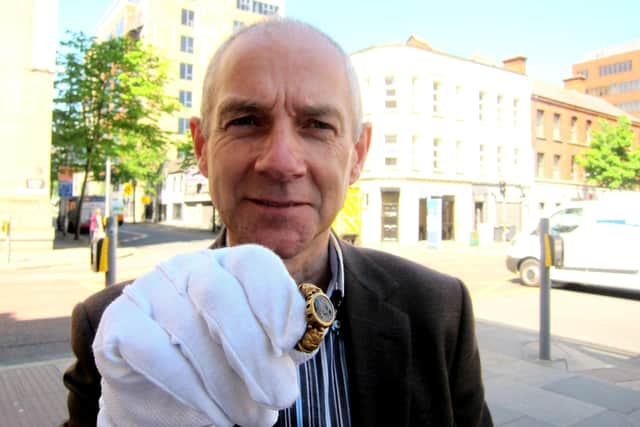Ireland ‘was treasure trove of good goldwork’
and live on Freeview channel 276
The comment came as the first six of 10 cases of potential treasure were considered at Belfast Coroner’s Court.
They were the first treasure trove inquests to be heard in several years due to the coronavirus pandemic.
Advertisement
Hide AdAdvertisement
Hide AdItems considered included a Bronze Age gold ring, a sleeve fastener, flat axes, an Agnus Dei pendant and medieval silver coins – all found by people using metal detectors with the permission of the landowner.


The final hearing of the day heard how Christopher Martin found the sleeve fastener around seven inches under the surface while using a metal detector in a field close to Narrow Water in Co Down on September 8, 2019.
It has been dated to around 3,000 years old, estimated to have been made between 950-800BC.
The item was described as “relatively small”, around 3cms in length, consisting of a semi-circular bow at either end, with a curved fastener.
Advertisement
Hide AdAdvertisement
Hide AdGreer Ramsey, curator of archaeology at National Museums Northern Ireland, said it was a piece of prehistoric Bronze Age gold jewellery.
He described the gold content as 83%, with 12% silver and 4% copper.
“This is really, really good quality gold,” he said.
“There are probably in the region of 100 sleeves fasteners from Ireland, and it is an exclusively Irish type, we’re not finding these objects on the continent.
“The goldsmiths in Ireland had a good reputation for producing high quality gold work. Ireland at one stage was called the El Dorado of western Europe because of the quality and quantity of the gold work.
Advertisement
Hide AdAdvertisement
Hide Ad“The term sleeve fastener is an antiquarian term, and became more popular in the 1960s. The idea was that it maybe acted perhaps like a cufflink, used to go through two slits and hold the cloak closed together, but we don’t know exactly how it worked.”
Coroner Anne-Louise Toal described it as a very beautiful piece, and declared it as treasure.
Earlier, three lots of items found by another metal detector enthusiast, Ryan Shiels, were declared to be treasure.
He described how it has been a hobby for him for around six years, usually going out three days a week weather permitting.
Advertisement
Hide AdAdvertisement
Hide AdOn April 3, 2019, he found a piece of a Bronze Age gold ring in a field close to the Co Down coast just south of Downpatrick.
On April 10, in the same field, he found 12 medieval silver coins.
And when he returned to the same field on April 15, he found more silver coins.
He also found four axes in the townland of Corbally, Co Down on March 5, 2020 and February 18, 2022.
Meanwhile, the Agnus Dei pendant was found in Lisnamallard, Co Fermanagh on November 13, 2018.